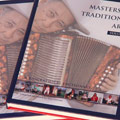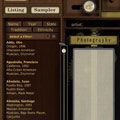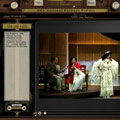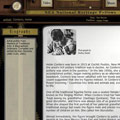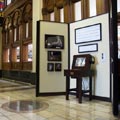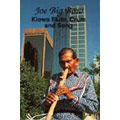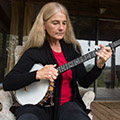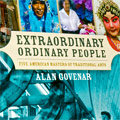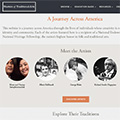Masters of Traditional Arts: A Biographical Dictionary
by Alan Govenar
About
Published: Santa Barbara, California and Oxford, England: ABC-CLIO, 2001
Details: Library Binding; 754 pages
Format: 2.10 x 11.22 x 8.74 in.
Also Includes: Bonus Interactive DVD-Rom featuring hours of audio/video content plus photos & more
An encyclopedia of the 259 recipients of the National Endowment for the Arts' National Heritage Award. Features biographies and photos of every recipient in two text-book bound volumes. Also includes a bonus Masters of Traditional Arts DVD-Rom (Mac/Windows) which includes hours and hours of audio and video content as well as additional photographs and bios that supplement the book. Teachers Guide available.
Reviews
From VOYA (Voice of Youth Advocates) August 2002
Review of Masters of Traditional Arts: Biographical Dictionary, Alan Govenar, Ed.
by DELIA CULBERSON
This extraordinary two-volume edition, twenty years in the making, is an impressive, well-crafted documentation of the prestigious National Heritage Fellowship Program sponsored by the National Endowment for the Arts. It gives a brief but comprehensive look at the interesting lives and outstanding achievements of its award-winning Fellows. More than two hundred and fifty folk artists are profiled – men and women superbly skilled in a particular art or craft whose natural talent, deep love for their work, and passionate dedication have made them all true masters in their fields. Most come from humble beginnings and even now lead modest lives. Few have acquired much wealth or fame, and several have overcome serious obstacles to pursue their calling. Americans all, they come from states across the nation, and from countries around the world. Their fields of expertise reflect this great diversity – an African American musician; an Asian American (Japanese) kabuki dancer; an Appalachian blacksmith; an Irish American singer; a Native American (Navajo) basket maker; a Puerto Rican hammock weaver; a Jewish klezmer musician, a Cajun fiddler; an Ukranian American egg decorator; a German American bobbin lace maker. Storytellers are noted alongside metalsmiths, boatbuilders, wood carvers, potters, quilters and more.
The entries, each less than two pages long, are well written, easy to read, and contain photographs of the artists. For teens and readers of all ages, this fine compendium is an excellent, informative, and entertaining resource. It is also an inspirational testimonial to the resilience, determination, and proud spirit of those artists who have triumphed over often inauspicious beginnings and adverse circumstances to express themselves through their art. By celebrating their artistic heritage and preserving their centuries-old traditions they leave a priceless legacy for future generations.
Copyright VOYA © 2002
From Booklist
The National Endowment for the Arts began the National Heritage Fellowship program in 1982 to recognize outstanding individual artists and different cultural styles. Nominated by the American public and selected by a panel of folklorists, ethnomusicologists, artists, and cultural specialists, fellows are chosen for their contributions to folk arts, mainly music, dance, crafts, and spoken-word traditions.
This set surveys the first 20 years of the National Heritage program by providing information about the lives and careers of the fellowship recipients. More than 250 artists profiled A-Z by name include accordionists, beadworkers, blues guitarists, hula masters, metalsmiths, quilters, saddle makers, santos carvers, singers, and storytellers. A photograph of the recipient and such basic information as craft, ethnic identification, and the artist's place and date of birth introduce individual entries. The entries themselves are short, usually a page or two, and are descriptive and biographical rather than analytical. Except for examples which appear in some artists' portraits, there are no photographs of artworks. Much of the entry material came from the program books created by the staff of the folk and traditional arts program of the NEA. The set includes a selected bibliography, discography, and filmography; a resource list; and a useful index. The index helps the reader locate entries by art form or ethnic heritage.
As an overview of the National Heritage Fellowship program's many folk and traditional art forms, this set will be of particular interest to libraries and teachers specializing in American folklore, cultural arts, and traditions. This set will complement the coverage of the Museum of American Folk Art Encyclopedia of Twentieth-Century American Folk Art and Artists (Abbeville, 1990).
RBB Copyright © American Library Association. All rights reserved
From Library Journal
For this unique biographical dictionary, folklorist/filmmaker Govenar draws on 20 years of interviews with participants in the National Heritage Fellowship program, a National Endowment for the Arts (NEA) program honoring American artists who practice the traditional or folk arts. Those represented include Afro-Cuban drummers, Ukrainian American egg decorators, Native American basket makers, African American tap dancers, Basque American accordionists, and Anglo American quilters. Arranged alphabetically by name, the entries each begin with a black-and-white photograph of the artist and list his or her ethnic identification. The essays, one to two pages of straightforward text, provide biographical information and details about the person's craft while also recognizing ethnic and cultural influences. The second volume concludes with an appendix about the Bess Lomax Hawes Award, the NEA's annual prize for excellence in the folk and traditional arts; as this was introduced in 2000, there are currently two entries. The book also features a resource list facilitating further research about the Heritage Fellows, a selected bibliography, discography, and filmography arranged by the artists' names, and an index that covers nationalities, ethnic groups, art forms, and personal names. Recommended for most public and academic libraries with an interest in the arts or ethnic and cultural studies.
Cynthia A. Johnson, Barnard Coll. Lib., New York
Copyright 2002 © Cahners Business Information, Inc.
From School Library Journal
Grade 9 Up-This resource chronicles the lives and careers of the 259 recipients of the National Heritage Fellowship, awarded annually since 1982 by the National Endowment for the Arts to individual practitioners of folk and traditional arts. Arranged alphabetically by artist's name, the entries do not follow a standard format, other than including the subjects' birth (and, where applicable, death), and dates and fields of artistic endeavor, and are not comprehensive biographies. Instead, they present an informative, anecdotal overview of those aspects of the subjects' lives that directly influenced their professional development. Each one- to three-page entry, based primarily on interviews with the artist, is accompanied by at least one black-and-white photograph, usually a portrait. Further resources on each artist are listed in the "Selected Bibliography, Discography, Filmography" which precedes the general index. The general index has an inconsistent format: a search for blues music yields a list of musicians with the page numbers of their entries, but under Cajun music there are only page references and no musicians' names. It is disappointing that the articles, especially those on quilters and other textile artists, do not include color photographs of their work. However, in his introduction, the editor mentions related DVD-ROM and interactive Internet resources. This set will be especially useful in large public libraries, academic libraries, art schools, music conservatories, and secondary schools that specialize in the arts.
Ginny Gustin, Sonoma County Library System, Santa Rosa, CA
Copyright © 2002 Cahners Business Information, Inc.
